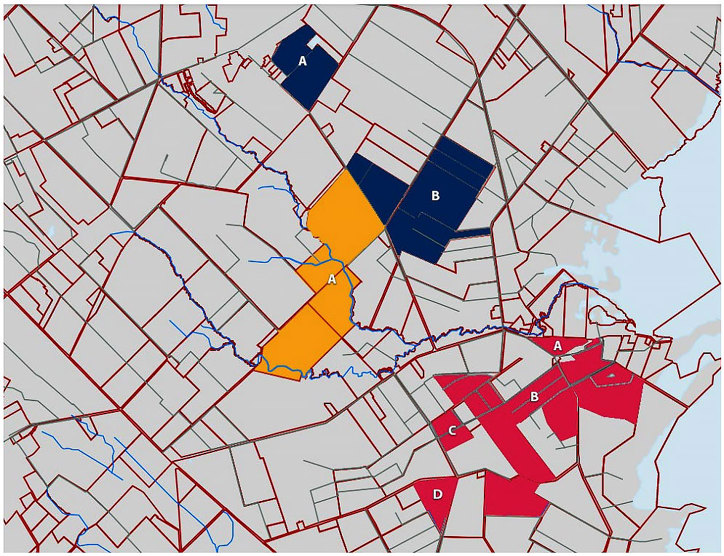Synthetic nitrogen fertiliser use
Application of synthetic nitrogen fertiliser to pastoral land
Excess nitrogen on the land can have profound effects on water quality and atmospheric chemistry. Although plants use and need nitrogen to grow, excess nitrogen is converted to its water-soluble form ‘nitrate’ by soil bacteria and then is easily delivered with water run-off to groundwater, streams, estuaries, and coastal water. An excess of nitrate acts as a pollutant in water systems disrupting the ecosystem and displacing fish and macroinvertebrates.
On 1 July 2021, the Government introduced a cap on the application of synthetic nitrogen fertiliser for land grazed by livestock under the new Essential Freshwater package.
FAQs - Synthetic nitrogen reporting
See our FAQs for more information about nitrogen use reporting requirements.
What are the rules?
- No more than 190kg/ha/year of synthetic fertiliser can be applied without a resource consent. This limit applies both as an average for the contiguous landholding, and to each hectare (with a limited exception for land used to grow annual forage crops).
- Dairy farmers must record synthetic nitrogen fertiliser use and report it back to us each year by 31 July.
Contiguous landholding is each adjoining or touching land parcel is considered part of the same farm, while land parcels that don’t border others are considered separate farms.

Example of a contiguous landholding (Image: Ministry for the Environment (MfE)).
The yellow farm has one continuous block of land. Although it is crossed by roads and streams, its paddocks adjoin both sides of those roads and streams and so form one contiguous landholding (labelled A). The blue farm has two contiguous landholdings (A and B) separated by land not belonging to the farm. Each comprises a block of adjoining paddocks, some of which straddle roads. The red farm has four contiguous landholdings – three small ones (A, C and D) and one large one (B) with multiple adjoining paddocks straddling roads.
How can I report on my nitrogen fertiliser use?
Regional councils are working closely with the Ministry for the Environment, fertiliser suppliers and the dairy sector to help farmers meet these requirements.
We know most farmers have close ties to their fertiliser suppliers. If you use one of the major fertiliser suppliers, such as Ravensdown or Ballance, they have the tools for you to collate all the necessary information, ready for you to check and submit to your regional council when you’re ready. We recommend you contact your supplier or farming services provider to find out more about this option as soon as possible.
The regional sector has developed a new national tool for reporting your usage. The N-cap Webform is available at: n-cap.teurukahika.govt.nz
YouTube playlist with instructions on using the Te Uru Kahika Nitrogen Cap web tool.
The Regional Sector who created the nitrogen reporting tool have put out a series of Youtube videos on how to submit nitrogen reports through the tool. This is to be used by Farmers / Consultants / Managers who are looking to report their synthetic nitrogen use (or lack thereof) on farms in New Zealand. The website referenced in these videos can be found here.
We understand other suppliers and agricultural service providers are also working on similar reporting tools.
- The Ravensdown HawkEye system is available at: www.hawkeye.farm
- The Ravensdown HawkEye app guidance is here: www.hawkeye.farm/support/nitrogen-reporting-quick-guide
- The MyBallance system is available at: www.myballance.co.nz
- The MyBallance app guidance is here: ballance.co.nz/myballance-how-to
Farmers should be aware that the reporting period for supplying similar information to milking companies is different.
What information will I need if I intend to report my Nitrogen use directly to my regional council, rather than via my fertiliser supplier?
To assist you with your calculations if you are planning on using the regional sector’s reporting tool, you can use the N–cap calculation spreadsheet (XLSX 101 KB) to generate your Nitrogen data that can be entered into the new data portal.
In addition to the spreadsheet, you will also need access to the following information:
- total land area of your farm in hectares
- total land area used for:
- grazed land split into:
- grazed forage crops
- grazed non-forage crops
- un-grazed land
- grazed land split into:
- kg of Nitrogen fertiliser applied for each land use category
- name/s of the fertiliser applied (including its Nitrogen percentage) for each land use category
- your New Zealand Business Number (check whether you have one, or apply for one)
- your Dairy Supply Number.
Categories of pastoral use land
| Grazed land (a.k.a. Pastoral use land) - Any land where grazing occurs | |
| Grazed forage crops (a.k.a. annual forage crops) - Grazed land other than pasture, not intended for harvest. |
|
|
Grazed non-forage crops (a.k.a. other land) - Grazed land other than grazed forage crops (i.e. grazed pasture and grazed harvest crops). Grazed harvest crops - Intermittently grazed crops that are intended for harvest (may include grains, grasses, trees). Grazed pasture - (a.k.a. pasture) - Grazed grassland, not intended for harvest. |
|
| Un-grazed land (a.k.a. land in other uses) - Land that is used for purposes other than grazing, for all or part of the year. |
More detailed guidance on the nitrogen caps for dairy farms can be found on the Ministry for the Environment website: environment.govt.nz
Frequently asked questions

